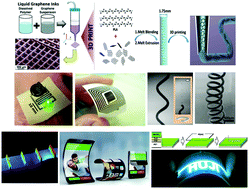Conductive nanomaterials for 2D and 3D printed flexible electronics
Abstract
This review describes recent developments in the field of conductive nanomaterials and their application in 2D and 3D printed flexible electronics, with particular emphasis on inks based on metal nanoparticles and nanowires, carbon nanotubes, and graphene sheets. We present the basic properties of these nanomaterials, their stabilization in dispersions, formulation of conductive inks and formation of conductive patterns on flexible substrates (polymers, paper, textile) by using various printing technologies and post-printing processes. Applications of conductive nanomaterials for fabrication of various 2D and 3D electronic devices are also briefly discussed.

- This article is part of the themed collection: Materials chemistry in flexible electronics


 Please wait while we load your content...
Please wait while we load your content...